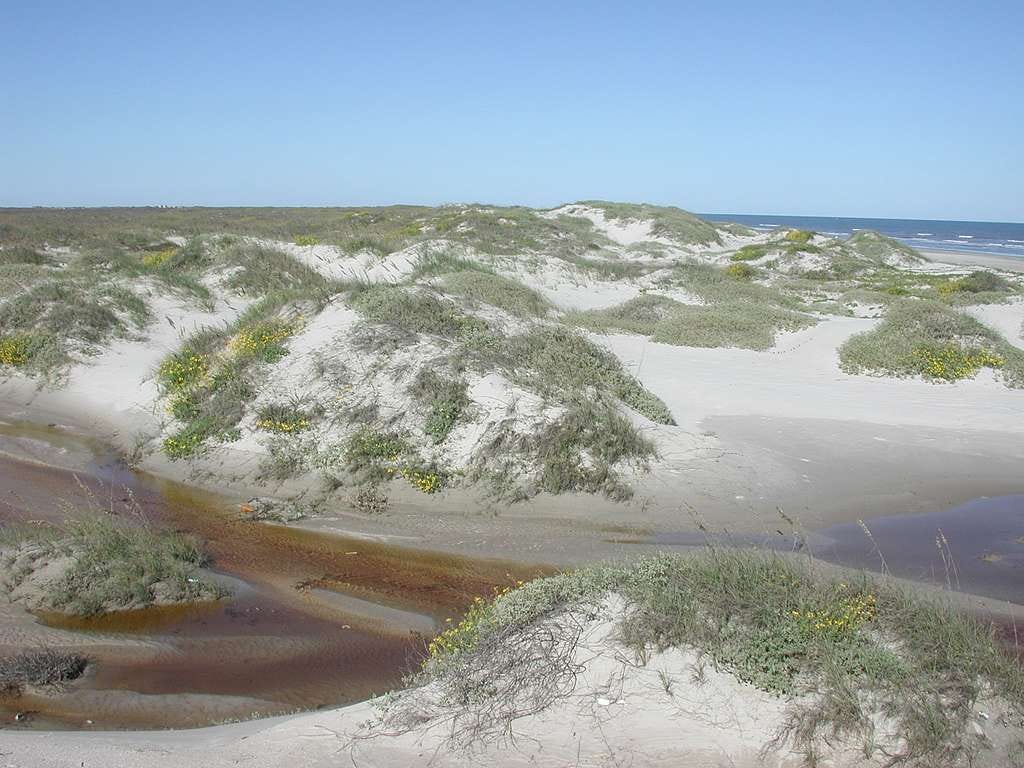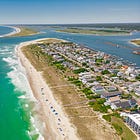Every winter, after breeding in central Canada and around the Dakotas, tens of thousands of Redhead ducks descend on the Laguna Madre, a large saltwater lagoon between Padre Island and Texas’s mainland. Redheads could choose many places to winter, yet the vast majority of them travel to this lagoon every year. Complex interactions between land, water, plants, and animals have combined over millennia to make this the perfect habitat for Redheads. Tracing interactions between species in this environment highlights both the rich ecologies and the high value of nature connected to America’s barrier islands.

This is the third post in a series exploring the climate problems facing America’s barrier islands. This week I highlight the value of nature on and around barrier islands through the lens of Padre Island in southeast Texas. Padre Island is the longest barrier island in the world and it’s one of the best preserved American barrier islands. Every barrier island is unique, but they all share the same basic ecosystems found on and around Padre Island.
Are you tired of taking baby steps in the race for our survival? Gumption is a space to make bold climate plans. Subscribe today and join a movement to make climate plans that save the world.
Barrier of Life
Every spring, pregnant Kemp’s Ridley sea turtles complete their journeys across oceans at the beaches of Padre Island. They slowly and awkwardly drag their bodies—sometimes weighing 100 pounds—onto the shore above the high tide line. Using their fins, they dig deep holes, deposit eggs into the soil, cover their nests, and return to the ocean. By summer, hatchlings emerge from their shells and scurry to the sea.
Turtles are only on the island for a few months each year, but they’re a vital part of the island’s ecology. The nests themselves are rich in nutrients that saturate the sandy soils of the beach. Over time, wind carries these nutrients across the island, creating rich soils for vegetation to grow.
Protected long enough from harsh winds by temporary dunes, sea oats take root. These grasses develop interconnected root systems into the dunes, anchoring the grass in place and helping it withstand salt sprays and occasional flooding from the ocean.
Grass-covered dunes are the backbone of Padre Island as they hold the island in place. As the dunes form and are strengthened by sea oats, the island can better shield the bay behind it from the energy of ocean waves and tidal flooding. Redhead ducks thrive in calm waters. If the dune system disappears, the bay would be exposed to heavy wave activity and would no longer be habitable for ducks and many other species.
People also benefit. With sea oats holding the dunes in place, the dunes can provide more friction against a storm surge, if not block the surge from reaching the bay entirely. This limits threats to human life and property for people living on the island and the mainland shore.
Sloping down from the dunes, the back shelf of Padre Island supports a rich diversity of life that supplies nutrients to the bay. Grasslands and forests provide habitats for animals of all sizes: from squirrels and rabbits to coyotes and deer. Over time, as these plants and animals die and are consumed by the soil, water carries their nutrients to the lagoon.

Lagoon of Eden
Padre Island protects one of the most productive natural habitats in the world: the Laguna Madre.
The Laguna Madre is a hypersaline lagoon, meaning its water is saltier than the ocean. With such high levels of salinity, you may assume this lagoon would be barren. And to the naked eye, the lagoon—a flat, teal surface of water with very few visible signs of life—doesn’t look like a thriving habitat. Yet look under the surface and you’ll find a vibrant microcosm of life.
Mudflats stretch hundreds of feet from Padre Island toward the mainland. Flooded daily, little vegetation grows in this environment, but dense networks of crustaceans, mollusks, worms, and other invertebrates bury themselves and thrive. All of these species form one of the Redhead duck’s main food groups, so the Redheads are prevalent along the Laguna Madre’s mudflats in winter.
Seagrasses are the Redhead’s other main food group. Similar to beach grasses, seagrasses take root in the lagoon’s soils and spread like a green carpet for miles. These grass structures are so extensive that seagrass meadows cover over 65% of the bottom of the lagoon. Seagrasses provide a safe habitat for many aquatic creatures, including fish, corals, crabs, and filter feeders like oysters. The floor of the Laguna Madre is like a submerged savannah brimming with life.
Together, the plants and animals of the Laguna Madre provide four vital services for people:
Carbon Sinks: The lagoon’s mud flats, wetlands, and seagrasses are highly effective carbon sinks. Known as “blue carbon” storage, coastal and ocean carbon sinks are responsible for absorbing about 17% of human carbon emissions today.
Water Filtration: Tidal grasses, seagrasses, and filter-feeding organisms like oysters passively filter pollutants out of the water.
Flood Defense: Tidal grasses and seagrasses provide friction against storm surges, reducing the impact of flooding on communities and reducing erosion.
Fish & Wildlife Economy: Recreational fishing is a major industry in places like the Laguna Madre for its diversity and abundance of fish species. Maintaining a healthy fishery helps maintain the local economy.
As spring emerges and Redhead ducks begin their annual migration to arctic breeding grounds, these and thousands of other birds take a little piece of Texas with them. Birds from the Laguna Madre carry seeds and nutrients from Texas and spread them over the American Midwest—America’s breadbasket—along with pest management services. We can, in part, thank these birds for the abundance of corn, soy, and other staple crops we enjoy every day. Losing the Laguna Madre, and the bird species it supports, could dramatically alter America’s food landscape.
However, the diversity and abundance of nature in and around the Laguna Madre depend on our ability to protect these ecosystems. Today, Padre Island and the Laguna Madre are protected and managed by the National Park Service. But even with federal support, these ecosystems are under threat.

Nature at Risk
Nature is at risk on and around America’s barrier islands, even on protected islands like Padre Island. Three primary forces threaten the survival of species on barrier islands: flooding, drought, and people.
The same flood risks that threaten human life threaten nature. As storm surges rise with sea levels, hurricanes and winter storms will increasingly inundate Padre Island and breach its beach dunes. Most plants behind the dunes die when submerged in salt water, so one breach of the dunes can wipe out an entire column of grasslands and forests. Tidal flooding will also increase, especially along the bay side of the island, gradually shrinking the space available for dry-land plants and animals. While Padre Island has natural mechanisms keeping the island above water, the island’s nature will be repeatedly traumatized by more flooding. With too much trauma, keystone species like sea oats may die, and with it, the structural backbone of the island could be compromised.
As global temperatures rise, droughts will be more common for Padre Island and the Laguna Madre. Drought isn’t just dangerous for life on land; it also threatens life in the bays and lagoons behind barrier islands. As freshwater sources from mainland streams and rivers dry up, saltwater from the ocean creeps further upland. Aquatic plants and animals that previously thrived in lower salinity levels are slowly poisoned by the water around them. Recent droughts in southeast Texas have killed thousands of fish in the Laguna Madre, and these droughts will only get worse with climate change.
The third, and perhaps most pressing threat to nature on America’s barrier islands is people. Overfishing has raked the floor of barrier island bays clean, leaving little natural habitat for aquatic species. Pollution from nearby industry and development has poisoned the waters of barrier island bays, further depriving aquatic life. And development on barrier islands has demolished precious terrestrial habitats. Even Padre Island—mostly protected by the National Park Service—is threatened by human activity.
Even more concerning is the threat of cascading shocks to nature. If a new development fills in a wetland, it reduces the availability of food for Redheads, causing lower populations of Redheads, less fertilizer from birds, starving seagrasses, increased erosion, and so on. Ecosystems are highly resilient, but when facing a future of successive traumas from multiple threats, even small losses of nature can compromise a web of vital ecosystem services.
Valuing Nature
Many researchers have tried to put a dollar value on the benefits nature provides to people. These can be helpful in specific policy contexts. But when thinking broadly about the competing interests on America’s barrier islands, I prefer to think about value qualitatively.
The ecosystems of Padre Island and the Laguna Madre touch people’s lives in so many ways—flood defense, carbon storage, water filtration, jobs, food security and so much more. Barrier island nature is the foundation on which millions of people’s lives and regional economies are built. Nature is perhaps barrier islands’ greatest asset.
The good news is that many powerful people understand this value. The bays and wetlands behind most of America’s barrier islands are highly regulated, preventing the most egregious forms of development and overfishing. Barrier island beaches on the East and Gulf coasts are mostly in the public domain and thousands of local organizations care for beach wildlife. And a growing army of scientists are uncovering the rich biodiversity connected to barrier islands and they’re making the case for protection.
But the work of preserving the ecosystems of America’s barrier islands is far from complete. Multiple forces—flooding, drought, and human activity—threaten nature on barrier islands. Our plans for the future of barrier islands should at minimum preserve the nature we have today. Great plans for barrier islands will strengthen and grow our natural resources.








